Newsletter: Liberty, justice and freedom for all? Happy Independence Day, everyone
- Share via
I’ve had this T-shirt since I was 17 — extra-large and so soft from decades of washings it hangs off my body like a second skin. It’s white with bold black-and-white text reading: “Keep Your Laws Off My Body.” Hi, I’m Deborah Vankin filling in for Carolina A. Miranda, and like so many others, reproductive rights have been on my mind this week.
I don’t know how I’ve managed to keep the T-shirt for so long — it just inadvertently ended up making the cut every time I packed up for a new city and new life stage. It’s lived in raucous college dormitories and, after graduation, traveled to a series of San Francisco flats, shared with a series of San Francisco boyfriends and one future husband; it took up residence in the shallow bottom drawer of a narrow Tokyo closet for several years before making its way to Boston grad school housing. In L.A., it got buried in the back of a townhouse’s walk-in closet years ago, all but forgotten, before ending up in a Silver Lake duplex where it now gets regular wear.
Each time I unpacked it, I saw the T-shirt in a new context. At 17, even with Roe vs. Wade long ago established, it felt urgent still, a symbol of a nascent political expression laced with teen rebellion. As the decades progressed, the cracked iron-on transfer felt like a reminder of a darker, more restrictive time — like my mother’s chipped mug celebrating the 19th Amendment and women’s right to vote.
The T-shirt now sparks with resurrected urgency after the U.S. Supreme Court’s ruling last week overturning Roe vs. Wade. It’s a pressing call to action. Liberty, justice, freedom for all — all of these presumed catchphrases that get bandied around this time of year take on new and tragically ironic meaning this Independence Day.
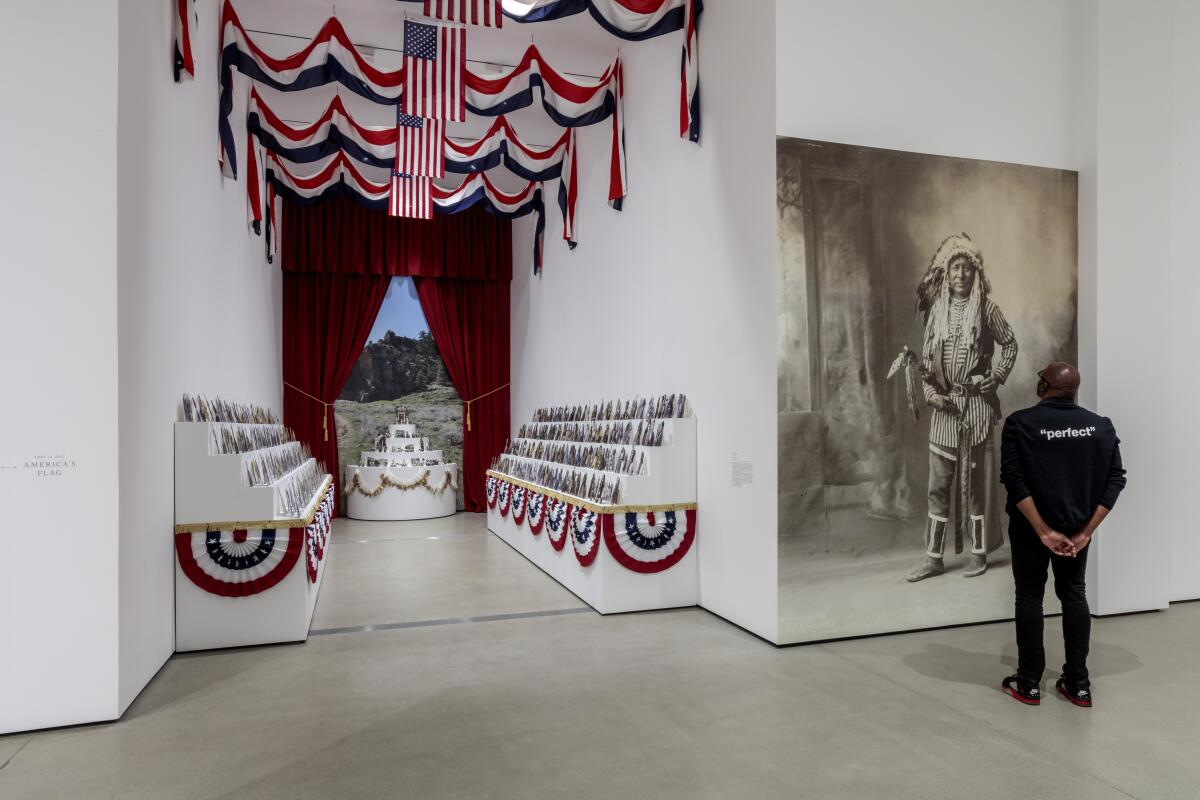
A special exhibition currently on view at the Broad museum — “This Is Not America’s Flag” — is also full of imagery that sparks with added resonance in this historic moment. The show features work by more than 20 artists, produced over several decades, dissecting and questioning the symbol of the American flag. It plumbs a cross section of political and social issues that run through the fabric of our country.
“My hope is that people walk away from the show thinking critically about what it means to be an active participant in our society,” Broad curator Sarah Loyer says in this edited conversation. “Not just about what the flag means, but what the U.S. means.”
The exhibition is informed by the murder of George Floyd along with the juxtaposition of two works in the Broad’s collection — how so?
Over the summer of 2020, we felt we had an opportunity to put together a show that would be more responsive to the moment, to both COVID-19 and the uprisings for racial justice following the murder of George Floyd. The shape of the show was informed by two pieces, Jasper Johns’ “Flag” from 1967 next to David Hammons’ “African-American Flag” from 1990 — Hammons’ work had just been acquired in 2019 and we hadn’t shown it yet. I felt like it was so very resonant with the moment, even though it had been made three decades ago at that time. So: a work from the ’60s, a work from the ’90s. Johns’ “Flag” made at the height of the Vietnam War and Hammons’ made, really, during the peak or beginning peak of the culture wars, which arguably we’re still living through. There are 22 artists, and most works range from the ’60s to the present.
The works probe identity politics, racism and gun violence, among other issues. Do any of the pieces speak to reproductive rights?
There aren’t any works that specifically take on that topic, but certainly there are works you could read through that lens. Stephanie Syjuco’s “Phantom Flag” (2018), the black chiffon flag hanging near the entrance to the show, feels like a flag in mourning to me. That piece was made in 2018 in response to what was happening at our borders at that time, with immigration. But [it’s also] thinking about the flag as a promise and what it means in those moments when that promise is broken. That’s a work that, even though it wasn’t made with reproductive rights in mind, we could look at a flag like that and relate to it in this moment.
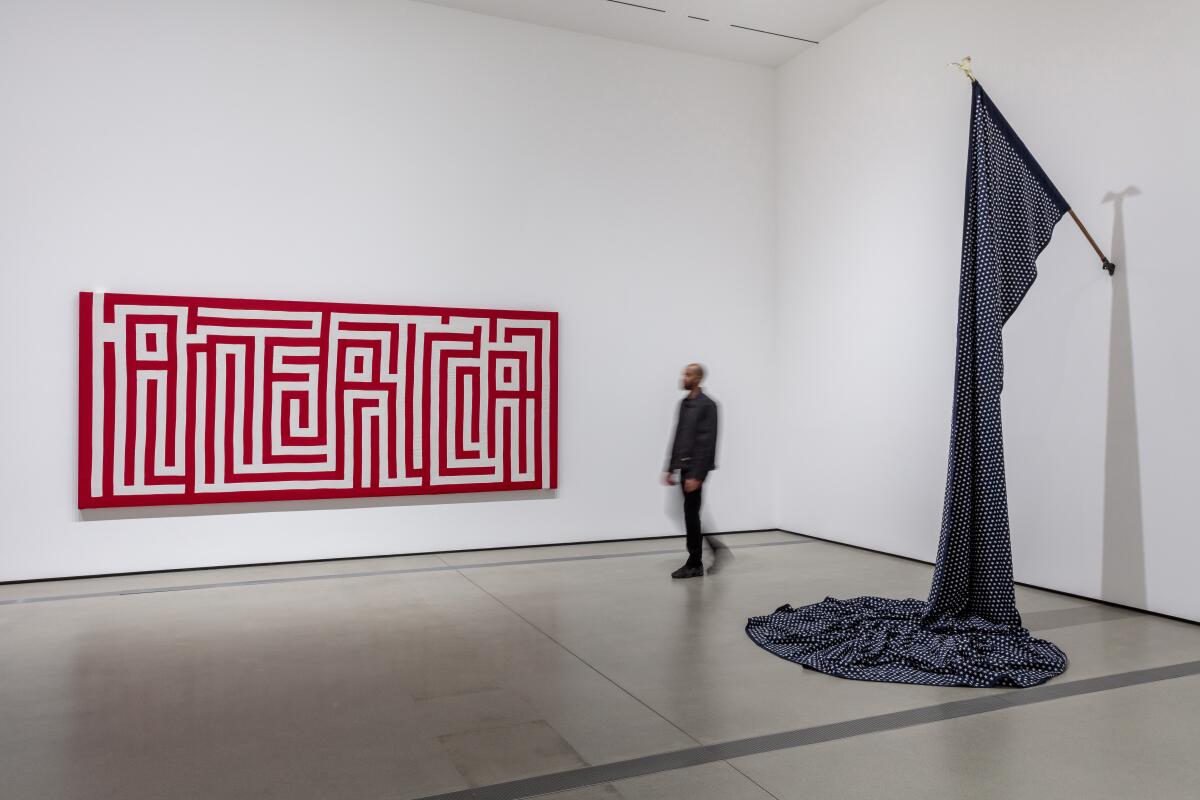
Hank Willis Thomas’ piece is especially powerful in how it addresses gun violence.
That piece is from a series — he’s done a piece each year with the number of deaths due to gun violence in the United States. And each star represents one life lost. The work is from 2018, but it counts the number of deaths in 2017. So the title of the work is “15,580 (2017).” It’s an ongoing series.
In what way does the exhibition explore the complexities of contemporary national identity?
There’s Laura Aguilar’s “Three Eagles Flying” (1990). She has the U.S. flag on her left, the Mexican flag on her right, and then she appears bound and gagged, nude, in the center covered by both of them. That’s a work that really looks at, even just the history of Southern California, and how each of those flags has been put on this land. And how those are two pieces of her own identity and how that can be restrictive. It speaks to that complexity directly. And we have several Indigenous artists in the exhibition. Wendy Red Star’s “The Indian Congress” (2021). The stars [on the flag], to her, each one represents land being taken from Native people. As a nation that has a Colonial history, there’s complexity and contradiction in that when we think about the flag standing for liberty.
And here’s what else is happening across the L.A. arts landscape.
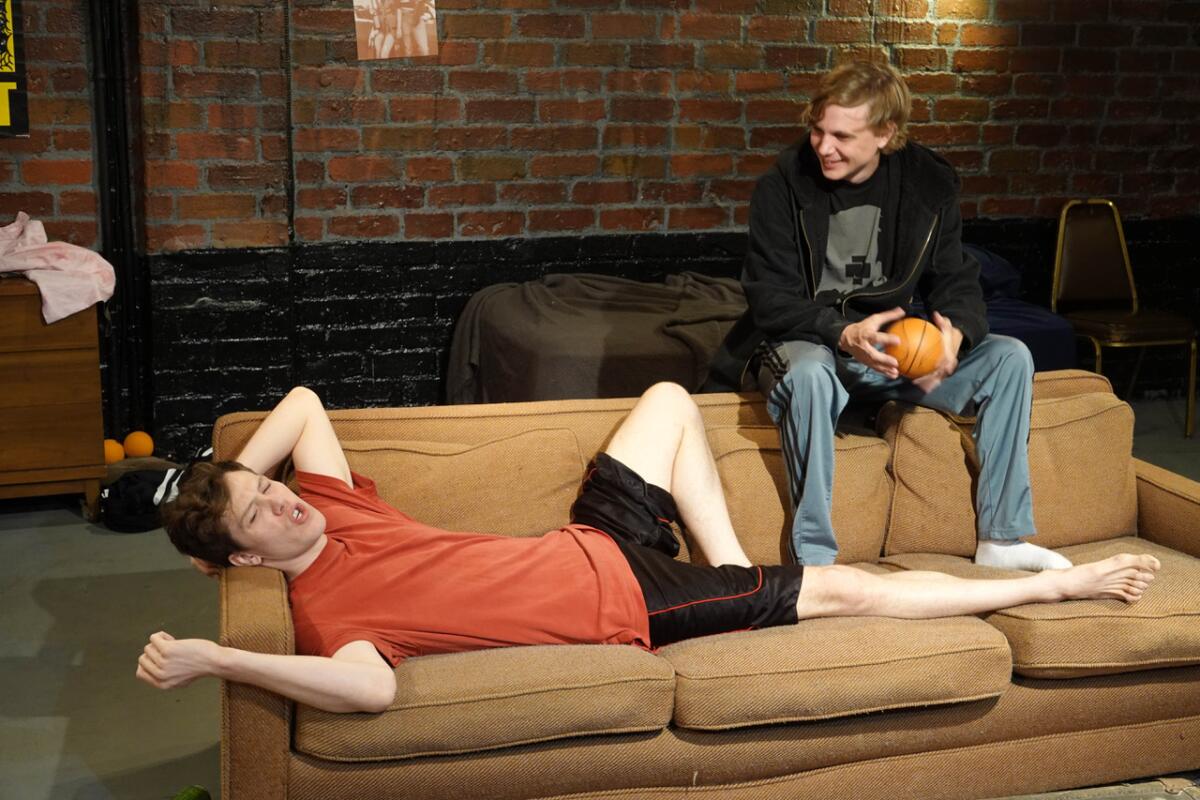
On the stage
A late 1990s basement sleepover for two high school boys, on the eve of a school shooting, is the setting of Tim Venable’s new play, “The Beautiful People,” at the Matrix Theatre. It is, at times, an “uncomfortable place for an audience to hang out,” Times theater critic Charles McNulty writes in his review.
“Venable’s focus is on masculinity,” McNulty says. “‘The Beautiful People,’ which is also the title of a [Marilyn] Manson song, traps us in this basement with the aggression, antagonism, vulnerability and sexual frustration of these young men.”
McNulty also reviews “To T, or Not To T? A Comedic Trans Journey through (T)estosterone and Masculinity.” In the one-person show, D’Lo — a Tamil Sri Lankan American actor, writer, comic and cultural worker — tells of coming to terms with his identity as a trans man.
“This is a coming-out story,” McNulty writes, “meaning it’s both an internal saga and a family drama. Emotion, recollected in tranquility, is alchemized into touching comedy.”
The show, a Los Angeles LGBT Center production, is directed and developed by Adelina Anthony and is being presented by Center Theatre Group at the Kirk Douglas Theatre as part of this year’s annual Block Party.

“Lempicka,” a Broadway-bound musical now at La Jolla Playhouse about the life and art of painter Tamara de Lempicka, is “as ambitious and complex as the painter it frames onstage,” reports Ashley Lee.
“For how absolutely dynamic she was, her story has been under-told,” director Rachel Chavkin tells Lee. “Tamara was a living intersection of so many movements and events of her time: She was queer, she was her family’s breadwinner, and she came of age between the two world wars, the exact moment that women were finally busting out of a whole series of historic constrictions.”
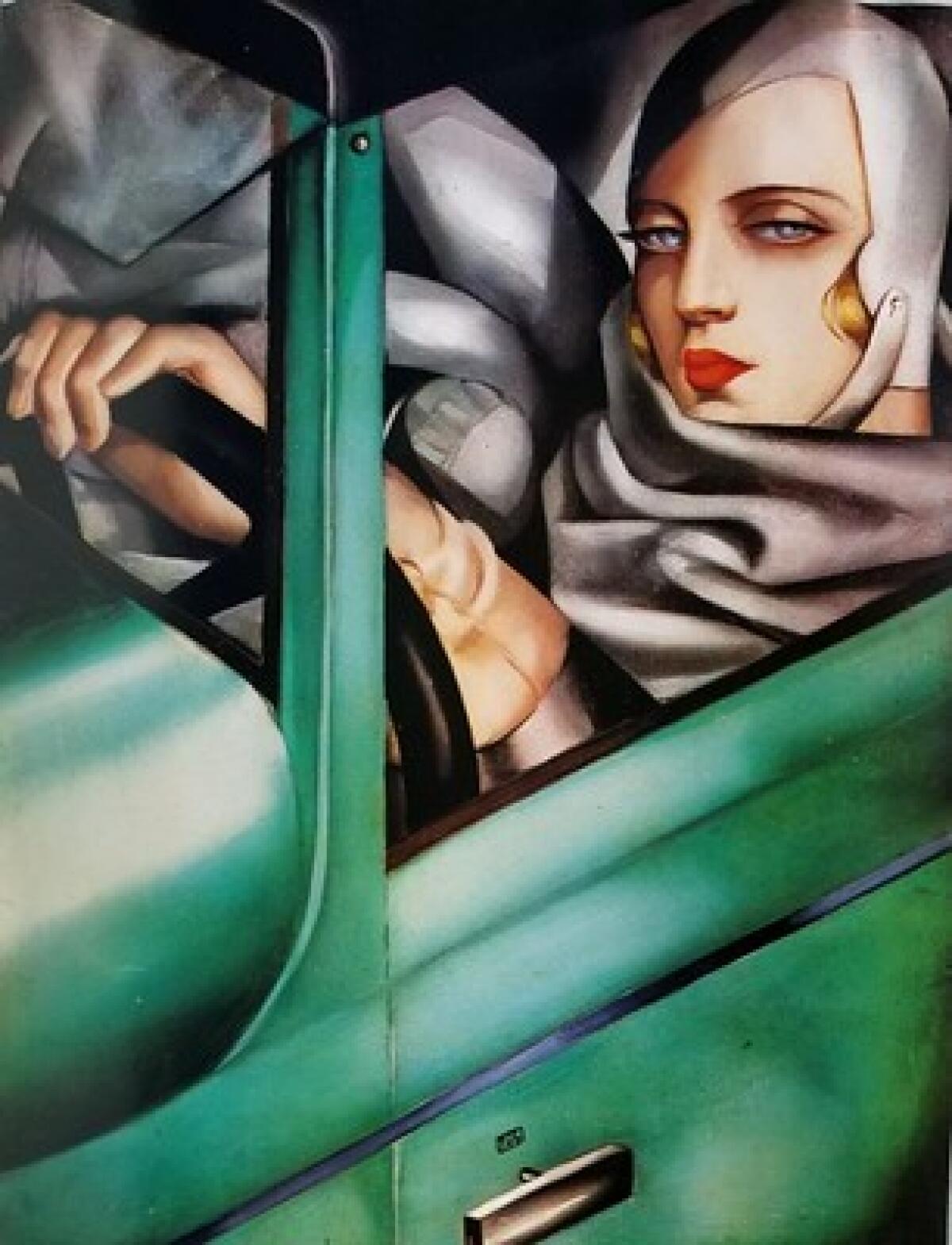
When the news leaked in May that SCOTUS would likely reverse Roe vs. Wade, the Fountain Theatre’s artistic director, Stephen Sachs, began planning a revival of Lisa Loomer’s 2016 play, “Roe,” which features the characters involved in the historic abortion rights case. The new production, a staged reading, is part obituary, part call to action, reports Margaret Gray.
“For the first time in the play’s life,” Gray writes, “its look back at the history of Roe vs. Wade didn’t seem like a fundamentally optimistic reminder of the price of our freedom. The whole context had changed.”
Make the most of L.A.
Get our guide to events and happenings in the SoCal arts scene. In your inbox every Monday and Friday morning.
You may occasionally receive promotional content from the Los Angeles Times.
Classical notes
New music, writes classical music critic Mark Swed, has “penetrated every pore of the classical music scene.” By his count, since April, the L.A. Philharmonic has presented works by 70 living composers, most of them premieres, and each program has included at least one new piece. Swed calls it “an exceptional phenomenon.”
“Thirty years ago, we might have hailed as rare and consequential any dozen weeks in which music by a mere handful of living composers was programmed as the regular course of a classical music season,” he writes. “When André Previn became music director of the L.A. Phil in 1985, he made a point of inviting critics to come to the rehearsals any time he was conducting a new piece, that being such an uncommon big deal. Now it is such business as usual that who has time to go to rehearsals?”
It’s not just at Walt Disney Concert Hall. New music, says Swed — at the Broad Stage, Zipper Hall, the Hollywood Bowl, REDCAT, Royce Hall, the Ford, the Wallis, the Dorothy Chandler Pavilion, art galleries, museums and in garden settings — has become, simply, a way of life.

Architecture
The new 6th Street Viaduct, a decadelong and $588-million public works project connecting Boyle Heights and downtown L.A.’s Arts District, is finally opening this month. The space, architect Michael Maltzan tells architecture and urban design columnist Carolina A. Miranda, “is like a huge civic hall.”
“It’s a project that has been scrutinized and dissected, hailed and assailed,” Miranda writes in her profile of Maltzan. “Soon it will beckon the public with a new form, a series of arches that bound effortlessly over a panoply of industrial sites just east of downtown, redefining the city’s skyline in the process. It also will have a revised function — one that attempts to soften the hard edges of transportation infrastructure, which have generally shown little regard for the communities in its path.”
A two-day community celebration, to mark the opening, is planned for July 9 and 10. It will include live performances by Ozomatli, La Sonora Dinamita and others, vintage cars, food trucks and handmade arts and crafts.
Bonus: The new bridge will feature protected bike lanes and pedestrian areas to encourage multimodal use.

Roger Vincent has a sneak peek at Frank Gehry’s new, $1-billion mixed-use complex, which is now nearing completion. The 45-story Grand LA complex is on Bunker Hill, downtown, across from his iconic Walt Disney Concert Hall. The project took nearly a decade to build and will include shops, restaurants, 436 apartments and a luxury hotel.
“Most developers don’t think of an architect that does that,” Gehry told The Times, pointing to Disney Hall, “as an architect who can do this. They pigeonhole you as the artsy guy.”
Enjoying this newsletter? Consider subscribing to the Los Angeles Times
Your support helps us deliver the news that matters most. Become a subscriber.
Visual art
Amid the growing call for cultural institutions to address diversity, equity and inclusion in their ranks, the Getty Foundation has launched a new initiative: the Getty Marrow Emerging Professionals pilot program. The two-year program, Steven Vargas reports, aims to connect historically underrepresented emerging arts professionals with mentors and networking opportunities to help them find full-time jobs at art museums and nonprofits in Los Angeles.
“Los Angeles is one of the most diverse cities in the world,” Getty Foundation Director Joan Weinstein says in the article. “Yet staff at museums and visual arts organizations don’t reflect the racial and ethnic diversity of the city.”

If you’re planning to navigate the museum world this weekend — or anytime in July — don’t leave home without Matt Cooper’s big ol’ list of this month’s exhibition openings across Southern California.
Among the new openings this month are the Getty’s show of work by members of a Black photographers collective, the Kamoinge Workshop, which was founded in the ‘60s; paintings and calligraphy by the self-taught Korean artist Park Dae Sung at LACMA; a group exhibition exploring food and community, before and during the pandemic, at the Armory Center for the Arts; and paintings by Chicana muralist Margaret Garcia at LA Plaza de Cultural y Artes.
In other art news ... in a scene right out of a Hollywood film, the FBI raided the Orlando Museum of Art last week, prematurely closing a Basquiat exhibition and seizing all 25 works on view. There are questions about the authenticity of the works in the show, “Heroes & Monsters: Jean-Michel Basquiat, The Thaddeus Mumford, Jr. Venice Collection,” the Art Newspaper reported.
Comedians on abortion
Comedians took to the stage to voice their rage over the reversal of Roe vs. Wade last weekend, including at the Hollywood Improv, UnCabaret at El Cid and as part of the Pro Roe Tour. The latter, a monthlong event, is organized by the roaming comedy club No Fuss Comedy Bus and will be held every other Saturday going forward near the corner of Lankershim and Victory boulevards in North Hollywood. Proceeds aid the Texas Equal Access Fund.
“People need to heal, and they need to feel seen and they need to feel heard,” comedian Iliza Shlesinger, who headlined last Saturday’s Pro Roe Comedy Show, told The Times. “If there was ever a moment to unleash and be unabashed, it’s this one.”
“Every time I throw one of these events, whether it’s people who attend, the vendors who give me a discount, [it] just reminds me how good people are,” said comic and show producer Taylor “Bugs” Streitz. “They are willing to come out and support one another, lend a helping hand, without getting anything in return. It’s amazing.”
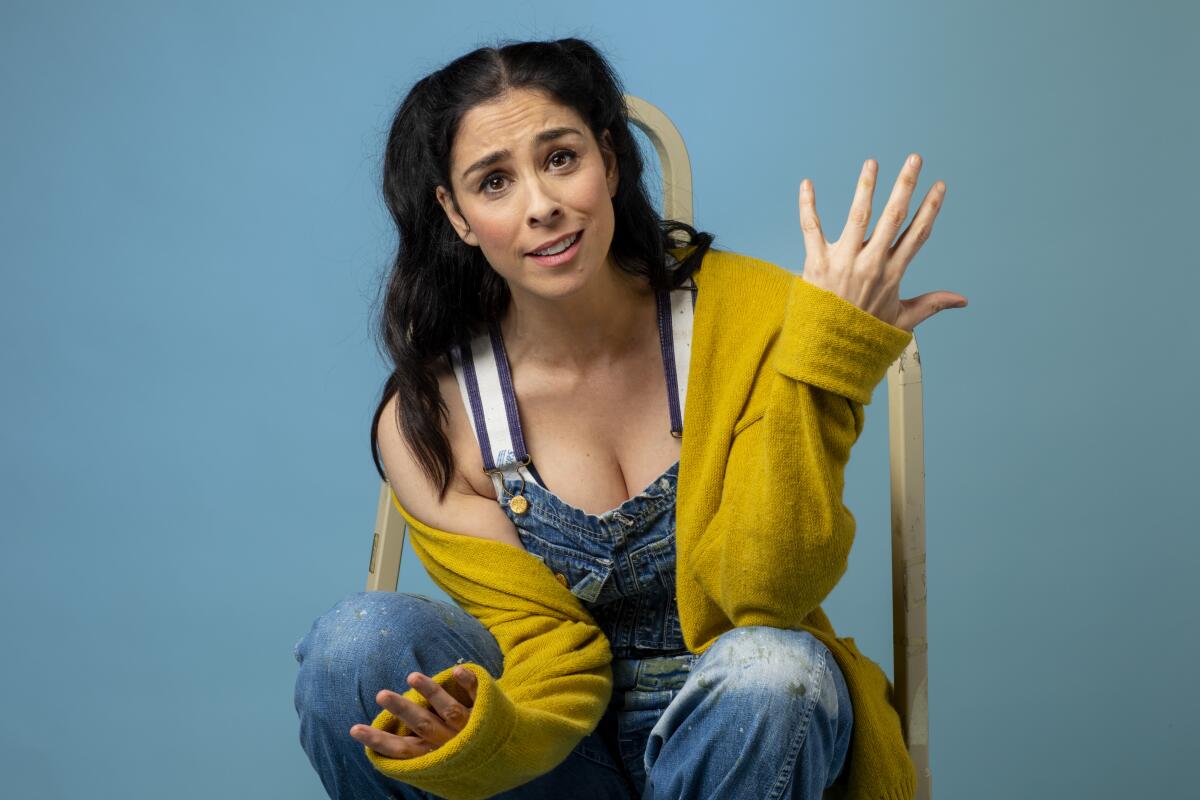
Essential happenings
The Tony-winning “Dear Evan Hansen” is back … so is the sci-fi classic “2001: A Space Odyssey.” And Sarah Silverman takes the stand-up stage to benefit the Downtown Women’s Center.
Let listings connoisseur, Cooper, curate your holiday weekend.
Passages
Trailblazing abstract painter Sam Gilliam passed away on Saturday, June 25. He was 88 years old.
In his appreciation, Times art critic Christopher Knight writes that Gilliam gained national attention in 1969 when, as part of a three-artist exhibition at Washington’s now-defunct Corcoran Gallery of Art, he suspended draped works from atrium skylights atop the beaux-arts building.
“Many Black artists at the time made paintings and sculptures in figurative modes that represented social and political themes,” Knight writes. “At the height of the civil rights movement in the nation’s capital, Gilliam’s inventive abstract gesture celebrating artistic difference was immediately embraced.”

Gilliam was born in Tupelo, Miss., and made his home in Washington, D.C., for six decades. He was known for boundary-pushing experimentation within painting and sculpture. He was also a prominent artist within the so-called Washington Color School — a movement in the 1950s focused on large fields of color.
Gilliam’s experimental, beveled-edge and drape paintings influenced generations of artists over a more than seven-decade career. His work was shown in a 1990 solo exhibition at Santa Monica’s Koplin Gallery. Times art critic William Wilson said at the time that the work “bristles with aluminum rings that jut from surfaces thickly and colorfully painted, then combed with a carpet rake. It is impossible to look at them and not think of Frank Stella’s big painting-cum-sculpture reliefs.”
In a Times review of Gilliam’s 2016 exhibition at L.A.’s David Kordansky Gallery, David Pagel called the work “a revelation.”
“The artist’s originality is on bare-naked display,” Pagel said. “So is the shape-shifting mutability of the materials he uses: acrylic paint, canvas and stretcher bars. In Gilliam’s hands, these elements come together in ways that make you think differently about what art does in the world and what we mean when we say an artist is a genius.”
Gilliam represented the U.S. at the 1972 Venice Biennale — the first African American artist to do so — as part of a group exhibition organized by curator and Ferus Gallery co-founder Walter Hopps. Forty-five years later, his large-scale nylon drape painting “Yves Klein Blue” was shown at the 2017 Venice Biennale.
Arne Glimcher of Pace Gallery — which represented Gilliam along with David Kordansky Gallery — said in a statement that the artist’s recent work “may be some of the greatest abstract paintings ever made. His experiments with color and surface are right up there with the achievements of Rothko and Pollock.”
David Kordansky called Gilliam “a heavyweight artist and a magician” who “embodied a vital spirit of freedom achieved with fearlessness, ferocity, sensitivity and poetry.”

And, finally ...
If the sparks off the daily news cycle haven’t been enough of a fireworks show for you this week, here’s where to see more — 21 of the city’s best fireworks displays this July Fourth weekend.
Feeling like taking it easy? Here are 10 books to add to your list this July.
The biggest entertainment stories
Get our big stories about Hollywood, film, television, music, arts, culture and more right in your inbox as soon as they publish.
You may occasionally receive promotional content from the Los Angeles Times.




